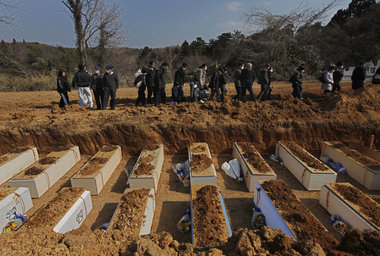As Tsunami Robbed Life, It Also Robs Rite of Death
By Michael Wines | Apr 03, 2011

HIGASHI-MATSUSHIMA, Japan — It was neither the place nor the time for a proper goodbye: not here, on a homely hilltop that used to house the city garbage incinerator. And not now, fully 12 days after a tsunami erased this town’s seacoast and forever sundered hundreds of families and friendships.
Yet on this raw, wind-whipped Wednesday afternoon, Fujimi and Ekuko Kimura watched as a procession of soldiers unloaded the coffin of Taishi Kimura, husband and son, from the back of an army truck, and laid it with 35 others in a narrow trench, partitioned into graves with pieces of plywood.
It was the rudest of funerals for a family already shouldering unbearable grief. It fell to the Kimuras — later, after the soldiers left — to turn a mass burial into a poignant and graceful farewell.
In Japan, it is not normal to bury the dead, much less to lay dozens side by side in a backhoe-dug furrow. Cremation is both nearly universal and an important rite in an elaborate funeral tradition deeply rooted in Buddhism.
But across coastal northeast Japan, tradition has collided this month with mathematical reality. The number of dead and missing from the March 11 tsunami has climbed past 22,000, and in the small towns and rural villages where most people died, there are by far too many bodies to burn.
Read more: http://www.nytimes.com/2011/03/24/world/asia/24burial.html?_r=1















